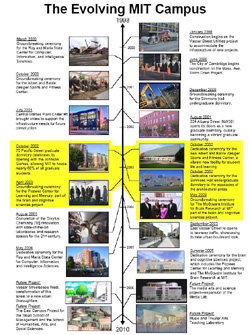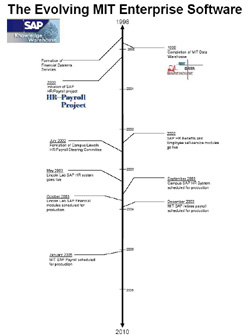Executive Vice President
With the close of the academic year 2003, I approach the end of my fifth year at MIT. The report for the current period is, in a sense, one frame in a moving picture. In this selective overview, I would like to give a sense of motion and direction to transformations in MIT's physical environment and its administrative practices. And to address the key role of design in both.
The rapid evolution of the MIT campus is perhaps the most dramatic evidence of transformation. From gleams in the eyes to steel, glass, bricks, and mortar, we have experienced seemingly continuous groundbreakings, construction disruptions, dedications, and move-ins. And as we are building the campus, the City of Cambridge, the Metropolitan District Commission, and the State of Massachusetts are rebuilding the streets around us from Massachusetts Avenue to Memorial Drive. Coordinating these projects with our own reconstruction of a new Vassar Street has been a grand challenge just to ensure that people can get into and out of MIT on any given day!
While physical transformation is the most obvious manifestation of change, it has not been the primary driver of our construction projects. Indeed, it is what our faculty, students, and staff do, or want and need to do—how they live or want to live—within new buildings that are the prime forces. And when great architects engage with these forces, they not only create spaces that satisfy needs and meet expectations, they raise the bar: through their own knowledge and creative engagement with clients, they help us discover both latent needs and new ideas to inform the building program and, hence, its physical realization: its design. The path from needs and aspirations to design and construction, when traversed well, is littered with surprise and invention. The consequences are buildings that work and designs that awaken and challenge our aesthetic senses.
 Click to see larger image.
Click to see larger image. |
The dynamic sense of the evolving physical MIT campus is conveyed by the chart The Evolving MIT Campus; the current movie frame, fiscal year 2003, is highlighted in yellow. This year saw the dedication of three buildings: Simmons Hall, the 70 Pacific Street graduate residence, and the Albert and Barrie Zesiger Sports and Fitness Center—all inspired in significant measure by the 1998 report of the Committee on Student Life and Learning. While documenting many aspects of life on the campus, the report stressed the need for more communal spaces, and the design of buildings that would foster a more interactive learning community. Simmons, with its caf��, large dining hall, many breakout rooms, multi-use amphitheater, Athena clusters, and faculty and visitor apartments, is a startling manifestation of what a path-breaking report, followed by a building program committee comprising faculty, students, staff and alumni, aided and abetted by a creative architect like Stephen Holl can create. While the building startles us with its innovative design and construction, it also contains a subtle reminder that not all great ideas are new: the dimensions of the student rooms in Simmons are similar to those in Baker House because students proclaimed the Alvar Alto–designed residence from the 1950s to be their "model".
The Zesiger Center, bursting with physical activity inside, also addresses the need for community spaces at MIT. A veritable melting pot of students, faculty, and staff, it is literally an overnight sensation. And contemporary as its elegant design is, it too has a neighborhood connection: Kevin Roche, the Z-Center design architect, completes the student activity "square" as envisioned in the 50s when he was working for Eero Saarinen on the design of Kresge Auditorium and the chapel.
The year 2003 also witnessed the completion of the comprehensive renovation of the Dreyfus Chemistry Building (Building 18), the renewal for 21st century chemistry of an I. M. Pei design from the 1960s; and the ground breaking for the McGovern Institute of Brain Research and the Picower Center for Learning and Memory, each a distinct part of a comprehensive brain and cognitive science project designed by Goody/Clancy and Charles Correa. The Frank Gehry–designed Ray and Maria Stata Center for Computer, Information, and Intelligence Sciences is revealing its extraordinary elements as the adjacent East Vassar Street project heralds its new urban mien. The Vassar Street project also represents the first phase of a multi-year program to address "the spaces in-between": the landscape, hardscape, and key passageways among the many destinations at MIT. Here, landscape architect Laurie Olin has been our guide.
In sum, then, the fourth year of what will be a decade-long moving picture of capital projects frames the buildings key to the student life and learning agenda envisioned in the 1998 report and reveals the shapes of buildings to come in support of science and engineering research at MIT. We can also see in these buildings, both completed and underway, realizations of President Vest's vision for campus development: "I believe the buildings on this extraordinary campus should be as diverse, innovative, and audacious as the community they support. They should stand as a metaphor for the ingenuity at work inside them."
 Click to see larger image.
Click to see larger image. |
During this same five years we have been engaged in another form of major construction: extending and building new SAP administrative systems to support enterprise-wide financial and human-resource transactions. The core SAP financial modules had been implemented before I arrived in 1998, and work was underway to develop a data warehouse to address the reporting complexities and deficiencies of the SAP product. With the warehouse implementation in 1999, our administrative and financial officers across the campus began to realize their aspirations for financial data and reports on their terms and their time lines. Further, with the creation of the office of Financial Systems Services, we began the gradual evolution of SAP towards its potential as a comprehensive enterprise application.
The year 2003 is an important frame in the software "construction" movie for MIT, as one can see from the accompanying chart, Evolving MIT Enterprise Software. Within the year, we formed the Campus/Lincoln HR Payroll System Steering Committee to solidify our new joint venture in software development and to leverage MIT's fixed costs of operating SAP. Building on the prior year's success in implementing the SAP HR benefits and employee self service modules, the joint team brought the SAP HR module successfully into production at Lincoln in May of 2003, and scheduled production for SAP HR on the campus in September. We could also schedule and anticipate successful "go lives" of SAP financial modules at Lincoln in October, and the first leg of Payroll—the retiree payroll—in December. Along the way, we will have eliminated six proprietary software applications, replacing them with one industry-standard integrated package and realizing the scale economies inherent in products like SAP. The implementations were minimally invasive across our user community thanks to the work of many process and policy design teams, and extensive communication, outreach, and training efforts.
So 2003 was a big year for technological as well as physical construction projects. The year also framed a major personnel change: Professor James D. Bruce announced he would retire after more than two decades of service as vice president for information systems. Jim had helped us prepare well for this day. Drawing on both extensive internal and external reviews of Information Systems and Financial Systems Services in the prior year, we were able quickly to convene and charge a distinguished search advisory committee and cast a nationwide net for Jim's successor. As 2003 passed into history, we had begun conversations with several distinguished finalists.
While this overview has been limited and selective, given the breadth and depth of the reports it covers, it exhibits the essential role of design in administrative work. Just as the way we design buildings enables and shapes the academic programs they contain, the way we design enterprise software applications enables and shapes the core business processes and information flows they encode. Done right, such projects sustain our academic and administrative activities for years to come: they are designed to evolve incrementally and relentlessly; they enable us to adapt to rapidly changing worlds.
On a personal note, I coauthored with Jon. C. Strauss the monograph Responsibility Center Management: Lessons from 25 Years of Decentralized Management (NACUBO, 2002). Individual unit reports follow.